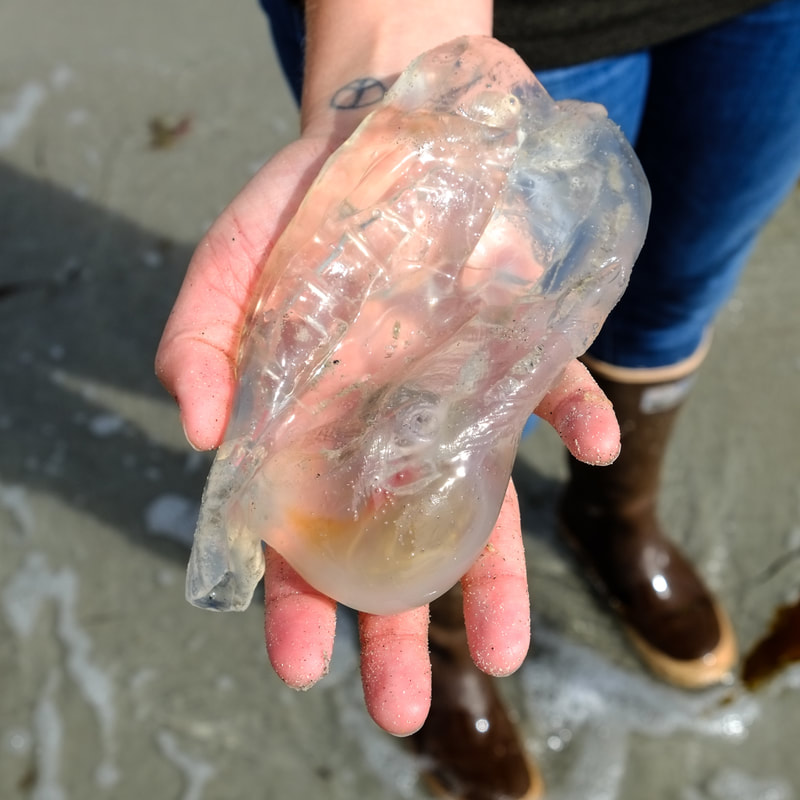Twin-sailed salp • Thetys vagina
{Thetys = seems to come from Tethys or Thetis, both figures from Greek mythology; vagina = from the Latin for "wrapper" or "sheath"}
Twin-sailed salp individual found washed up on West Beach, Calvert Island. Photos by Brian Starzomski.
Identification
Washed up on a beach the twin-sailed salp may appear like an oddly-shaped, tentacle-less jelly — however it is actually a type of free-floating tunicate. As with other salps, this gelatinous and translucent animal takes on two different forms: a solitary individual form, and an aggregate colonial form arranged into a long chain of connected zooids (individuals). In both forms the individuals are barrel-shaped with a thick and rigid outer casing (tunic) that is covered in small bumps. The animal's digestive system is visible as a dark or colourful lump suspended in the translucent body. The solitary form is "striped" with around twenty or more partial bands of muscle, while the aggregate form has only five muscle bands. The solitary form also has two long dark tail-like appendages. With individuals measuring up to 33 cm long, this is the largest recorded salp species.
See images and observation records on the iNaturalist species page.
Habitat & Range
This pelagic animal is found from the surface to 150 m deep in temperate and tropical waters in the Pacific, Atlantic, and Indian Oceans. The Central Coast of BC is its northernmost recorded range in the Pacific Northwest.
Intriguing Info
Salps consume plankton by taking in water at one end, filtering out the plankton with an internal mucuous net, and expelling the water out the other end (and propelling themselves forward in the process) — earning themselves the title of "vacuum cleaners of the ocean". Carbon-containing waste is packed into dense pellets which sink to the ocean floor, thus removing carbon from surface waters. Click here to read more and to learn about research that examined this process.
Read more about this salp on this blog post by The Marine Detective.
iNaturalist
https://www.inaturalist.org/taxa/133222-Thetys-vagina
Washed up on a beach the twin-sailed salp may appear like an oddly-shaped, tentacle-less jelly — however it is actually a type of free-floating tunicate. As with other salps, this gelatinous and translucent animal takes on two different forms: a solitary individual form, and an aggregate colonial form arranged into a long chain of connected zooids (individuals). In both forms the individuals are barrel-shaped with a thick and rigid outer casing (tunic) that is covered in small bumps. The animal's digestive system is visible as a dark or colourful lump suspended in the translucent body. The solitary form is "striped" with around twenty or more partial bands of muscle, while the aggregate form has only five muscle bands. The solitary form also has two long dark tail-like appendages. With individuals measuring up to 33 cm long, this is the largest recorded salp species.
See images and observation records on the iNaturalist species page.
Habitat & Range
This pelagic animal is found from the surface to 150 m deep in temperate and tropical waters in the Pacific, Atlantic, and Indian Oceans. The Central Coast of BC is its northernmost recorded range in the Pacific Northwest.
Intriguing Info
Salps consume plankton by taking in water at one end, filtering out the plankton with an internal mucuous net, and expelling the water out the other end (and propelling themselves forward in the process) — earning themselves the title of "vacuum cleaners of the ocean". Carbon-containing waste is packed into dense pellets which sink to the ocean floor, thus removing carbon from surface waters. Click here to read more and to learn about research that examined this process.
Read more about this salp on this blog post by The Marine Detective.
iNaturalist
https://www.inaturalist.org/taxa/133222-Thetys-vagina
References
Greenberg, J., Madin, K., and Lippsett, L. (2010). Salps Catch the Ocean's Tiniest Organisms. Oceanus Magazine. Woods Hole Oceanographic Institution.
Jackie Hildering. (2015). Otherwordly Drifter. Mind Blown. The Marine Detective. Accessed 03/08/2018.
Lamb, A. and Hanby, B. Marine Life of the Pacific Northwest [electronic version]. Madeira Park, BC: Harbour Publishing.
Thetys vagina. Zooplankton Guide. Scripps Institute of Oceanography. Accessed 03/08/2018.
Authors and editors of page
Kelly Fretwell (2018)
Greenberg, J., Madin, K., and Lippsett, L. (2010). Salps Catch the Ocean's Tiniest Organisms. Oceanus Magazine. Woods Hole Oceanographic Institution.
Jackie Hildering. (2015). Otherwordly Drifter. Mind Blown. The Marine Detective. Accessed 03/08/2018.
Lamb, A. and Hanby, B. Marine Life of the Pacific Northwest [electronic version]. Madeira Park, BC: Harbour Publishing.
Thetys vagina. Zooplankton Guide. Scripps Institute of Oceanography. Accessed 03/08/2018.
Authors and editors of page
Kelly Fretwell (2018)






